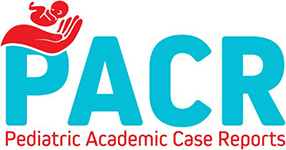Severe Costochondral Pain in a 16-year-old Female Patient
Alkü Alanya Training And Research Hospital, Pediatrics, Antalya, Türkiye
Keywords: Costochondral pain, costochondritis, methylprednisolone, adolescents
Abstract
Costochondral pain can be a diagnostic challenge, especially following an acute disease. We present the case of a 16-year-old female patient who presented with developed severe costochondral pain following influenza A-related pneumonia. Despite initial treatment, her symptoms worsened, leading to significant impairment in her daily activities. Comprehensive investigations, including laboratory tests and imaging studies, were inconclusive. However, treatment with methylprednisolone led to a dramatic improvement in her symptoms. This case highlights the significance of considering inflammatory processes in the differential diagnosis of costochondral pain, especially in adolescents.
Introduction
Costochondral pain can be a diagnostic challenge, especially when it occurs in the context of a recent disease. It is of the utmost importance to differentiate between chest pain caused by costochondritis and other conditions that may present with similar symptoms in children. Additionally, sharp and unilateral pain may be indicative of different conditions, such as pneumonia, parapneumonic effusion, and pleuritis, and the absence of respiratory distress, fever, cough and radiological findings for this condition allows for the exclusion of these diagnoses. It is also possible that gastrointestinal conditions, such as gastroesophageal reflux, peptic ulcer or pancreatitis, may be the cause of the chest pain. It is therefore important to conduct a comprehensive examination of the patient, considering the relationship between pain and food intake, as well as other symptoms of reflux. Furthermore, conditions, such as pericarditis, myocarditis, arrhythmias and, on rare occasions, acute coronary syndrome may be the underlying cause of the chest pain, and may be mistaken for costochondritis [1,2]. Therefore, patients should undergo a comprehensive blood test, including infection parameters, cardiac enzymes, electrocardography, chest x-ray and, if necessary, MR imaging to gain a more detailed understanding of the musculoskeletal structure. When cardiac causes cannot be excluded, a paediatric cardiology consultation and echocardiography should be conducted. In this case report, we describe the presentation, diagnosis, and management of severe costochondral pain in a 16-year-old female patient following influenza A-associated pneumonia.
Case Report
A 16-year-old female patient was admitted to our hospital with severe costochondral pain, which had developed approximately one month after hospitalization for pneumonia caused by influenza A. Despite initial treatment during her previous hospitalization, her symptoms progressively worsened, with severe pain localized to both sides of the costal arches and costochondral junctions. The patient had been unable to attend school for approximately one month due to severe pain, and daily activities were significantly restricted. Physical examination revealed tenderness upon palpation of the costal arches without other notable findings.
Laboratory investigations, including complete blood count, C-reactive protein (CRP), erythrocyte sedimentation rate (ESR), and biochemical parameters, were within normal limits. The anti-nucleer antibody (ANA) were negative. Chest X-ray and contrast-enhanced thoracic computed tomography (CT) scans showed no abnormalities. In addition, magnetic resonance imaging (MRI) showed that the muscle and bone structures of the chest wall were normal. No pathological MRI signal was detected in the osseous structures within the examination field. The trachea, esophagus, major vascular structures, and cardiac silhouette were within normal limits. No abnormal-sized lymph nodes were observed in the mediastinal and hilar regions. Minimal fluid was observed in bilateral pleural spaces. No area of nodular lesion was seen in the lung parenchyma. The patient was consulted with pediatric cardiology, and the echocardiogram was considered normal. Vitamin D replacement therapy was initiated due to the 25-hydroxy vitamin D level being 14 µg/L
Despite analgesic therapy with ibuprofen, the patient continued to have severe pain. The patient's symptoms dramatically decreased starting from the 3rd day after adding methylprednisolone at a dose of 2 mg/kg/day to the treatment. After continuing methylprednisolone treatment at a dose of 2 mg/kg/day for three days, it was gradually tapered and discontinued on the 10th day, with the patient experiencing sustained relief of her symptoms.
Discussion
Costochondritis accounts for a significant portion of non-cardiac chest pain in the pediatric and adolescent patient population[1,2]. The etiology of costochondral pain in our patient remained elusive despite extensive investigations, including laboratory and imaging studies, but our patient has a vitamin D deficiency, and there are studies in the literature suggesting that vitamin D deficiency may lead to hypertrophy in the costochondral junction and pain in the sternum. [3,4]. Similar cases of severe costochondral pain have been observed following COVID-19 [5]. However, the dramatic response to methylprednisolone suggests an underlying inflammatory process, possibly triggered by the preceding influenza A infection. Inflammatory conditions involving the costochondral junctions, such as costochondritis or Tietze syndrome, should be considered in the differential diagnosis of severe costochondral pain.
Conclusion
This case highlights the importance of considering inflammatory processes in the differential diagnosis of costochondral pain, especially in adolescents with a recent history of acute disease. Methylprednisolone therapy may be effective in relieving symptoms when other treatment modalities fail. Further research is needed to elucidate the this condition’s underlying pathophysiological mechanisms and optimal management strategies.
Cite this article as: Uzkan S, Korkmaz MF, Altın H. Severe Costochondral Pain in a 16-year-old Female Patient. Pediatr Acad Case Rep. 2025;4(1):5-7.
The parents’ of this patient consent was obtained for this study.
The authors declared no conflicts of interest with respect to authorship and/or publication of the article.
The authors received no financial support for the research and/or publication of this article.
References
- Pamuk U, Gürsu A. Chest pain in children. Turk J Pediatr Dis 2023;17(4):328-33.
- Doğan M, Baykan A, Özer U, et al. Evaluation of children and adolescents admitted to the emergency department with complaints of chest pain. Curr Pediatr 2022;20(2):122-127.
- Ghandi Y, Habibi D, Mohajer O. Assessment of correlation between costochondritis and vitamin D insufficiency in school-age children. J Compr Ped 2021;12(3): e102388.
- Oh RC, Johnson JD. Chest pain and costochondritis associated with vitamin D deficiency: a report of two cases. Case Rep Med 2012;2012:375730.
- Collins RA, Ray N, Ratheal K, et al. Severe post-COVID-19 costochondritis in children. Proc (Bayl Univ Med Cent) 2022; 35(1): 56-7.


